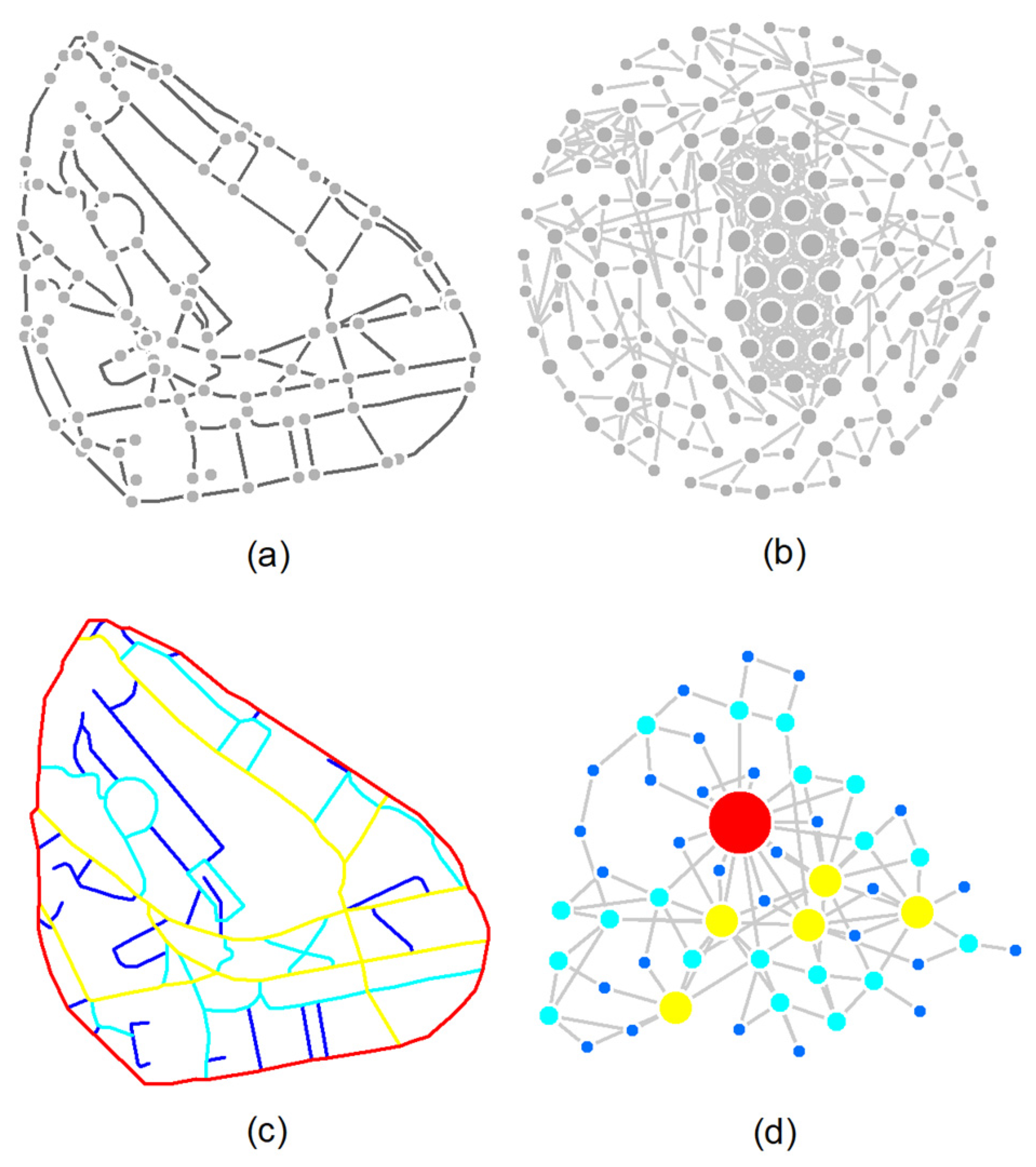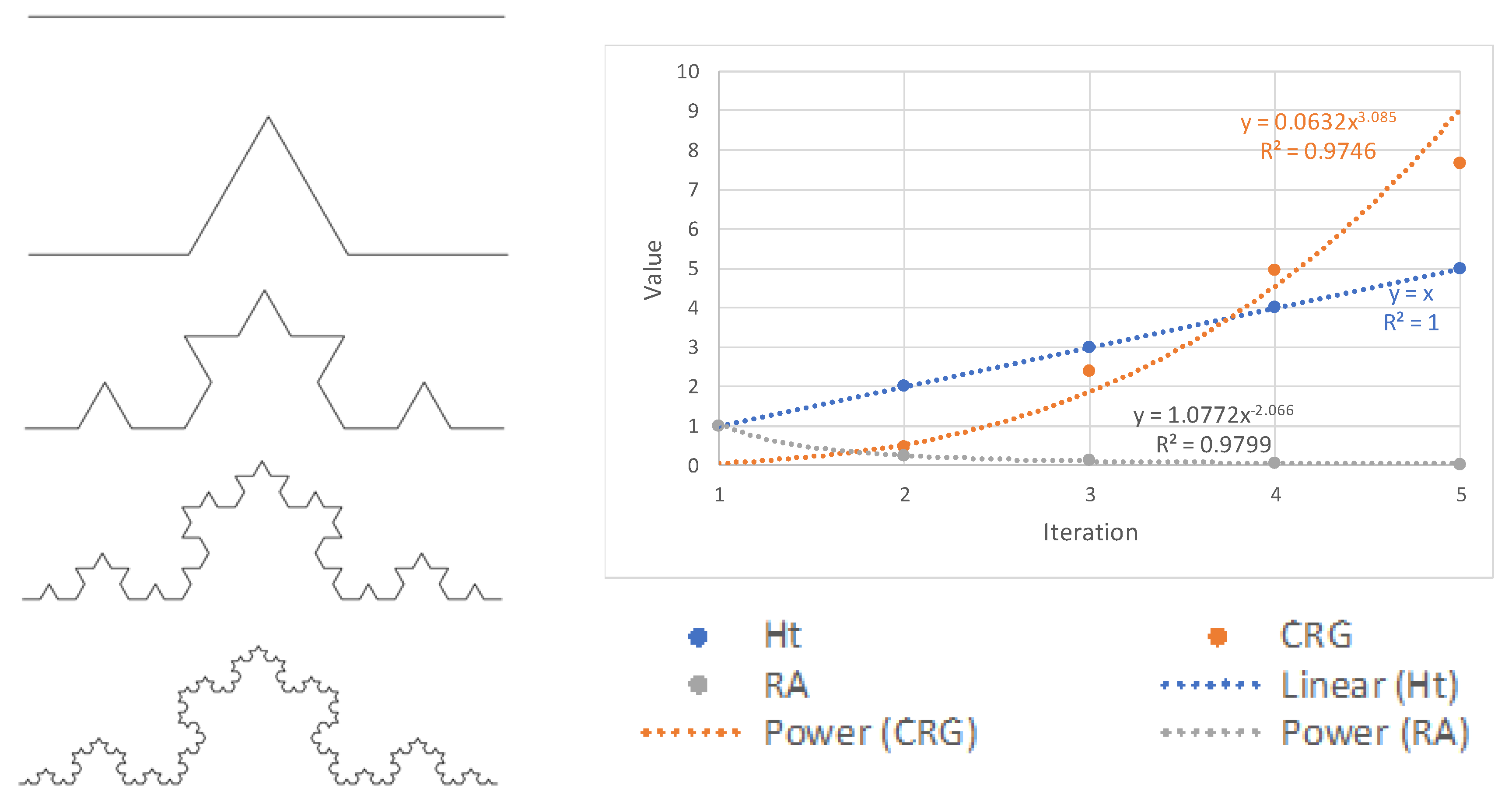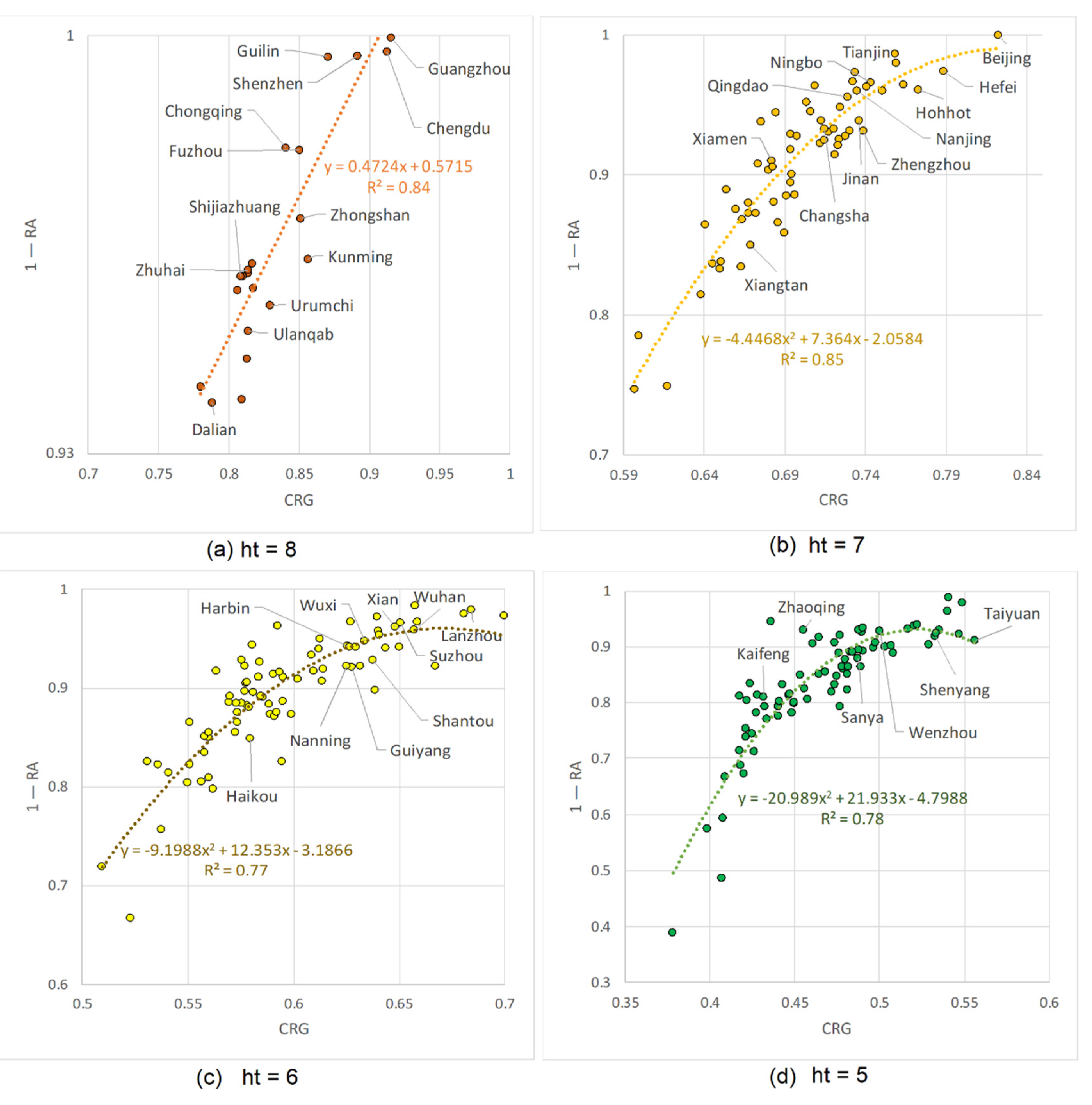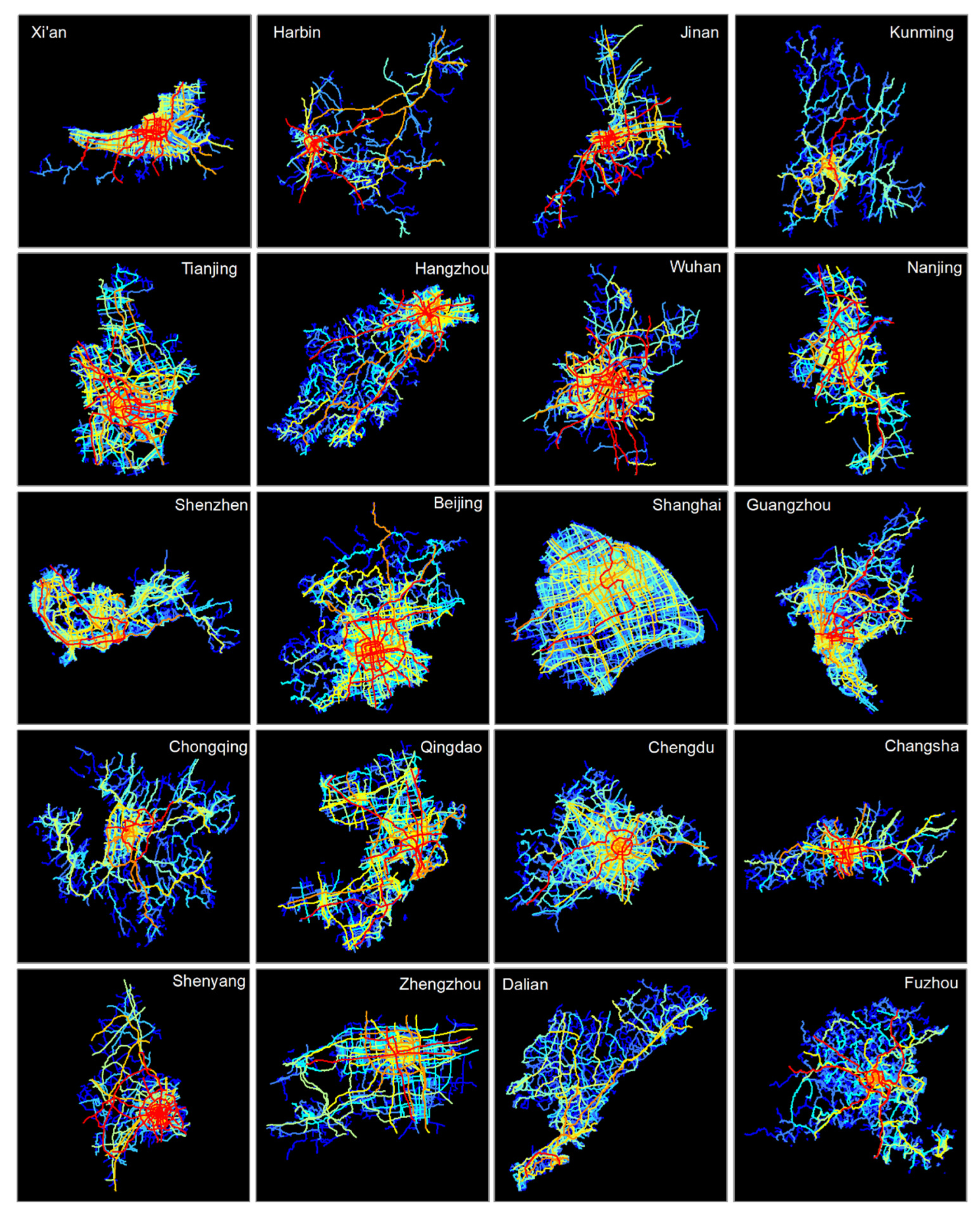Understanding Chinese Urban Form: The Universal Fractal Pattern of Street Networks over 298 Cities
Abstract
1. Introduction
2. Data and Methods
2.1. Data and Data Processing
2.2. Transformation from Segment–Segment Topology to Street–Street Topology
2.3. Fractal Analysis of Street Connectivities
2.3.1. Power Law Detection
2.3.2. Integration of Ht-Index, CRG, and RA for Fractal Measurement
2.4. Regression Analysis
3. Results and Discussion
3.1. The Universal Fractal Pattern of 298 Urban Street Networks
3.2. Correlations between Fractal Metrics and Urban Quantities
4. Further Discussion of this Study
5. Conclusions
Author Contributions
Funding
Conflicts of Interest
References
- Ma, D.; Jiang, B. A smooth curve as a fractal under the third definition. Cartographica 2018, 53, 203–210. [Google Scholar] [CrossRef]
- Boeing, G. Measuring the complexity of urban form and design. Urban Des. Int. 2018, 23, 281–292. [Google Scholar] [CrossRef]
- Gao, P.; Cushman, S.A.; Liu, G.; Ye, S.; Shen, S.; Chang, C. Fracl: A tool for characterizing the fractality of landscape gradients from a new perspective. ISPRS Int. J. Geo-Inf. 2019, 8, 466. [Google Scholar] [CrossRef]
- Koch, H. Sur une courbe continue sans tangent, obtenue par une construction géométrique élémentaire on a continuous curve without tangents constructible from elementary geometry. Arkiv Matematik 1904, 1, 681–704. [Google Scholar]
- Mandelbrot, B. How long is the coast of Britain? Statistical self-similarity and fractional dimension. Science 1967, 156, 636–638. [Google Scholar] [CrossRef] [PubMed]
- Jiang, B.; Yin, J. Ht–index for quantifying the fractal or scaling structure of geographic features. Ann. Assoc. Am. Geogr. 2014, 104, 530–541. [Google Scholar] [CrossRef]
- Batty, M.; Longley, P. Fractal Cities: A Geometry of Form and Function; Academic Press: London, UK, 1994. [Google Scholar]
- Batty, M.; Carvalho, R.; Hudson-Smith, A.; Milton, R.; Smith, D.; Steadman, P. Scaling and allometry in the building geometries of Greater London. Eur. Phys. J. B 2008, 63, 303–314. [Google Scholar] [CrossRef]
- Tannier, C.; Thomas, I.; Vuidel, G.; Frankhauser, P. A fractal approach to identifying urban boundaries. Geogr. Anal. 2011, 43, 211–227. [Google Scholar] [CrossRef]
- Tannier, C.; Thomas, I. Defining and characterizing urban boundaries: A fractal analysis of theoretical cities and Belgian cities. Comput. Environ. Urban Syst. 2013, 41, 234–248. [Google Scholar] [CrossRef]
- Thomas, I.; Frankhauser, P. Fractal dimensions of the built-up footprint: Buildings versus roads. Fractal evidence from Antwerp (Belgium). Environ. Plan. B Urban Anal. City Sci. 2013, 40, 310–329. [Google Scholar] [CrossRef]
- Shreevastava, A.; Rao, P.S.C.; McGrath, G.S. Emergent self-similarity and scaling properties of fractal intra-urban heat islets for diverse global cities. Phys. Rev. E 2019, 100, 032142. [Google Scholar] [CrossRef] [PubMed]
- Shen, G. Fractal dimension and fractal growth of urbanized areas. Int. J. Geogr. Inf. Sci. 2002, 16, 419–437. [Google Scholar] [CrossRef]
- Mohajeri, N.; Gudmundsson, A. The evolution and complexity of urban street networks. Geogr. Anal. 2014, 46, 345–367. [Google Scholar] [CrossRef]
- Nilsson, L.; Gil, J. The signature of organic urban growth. In The Mathematics of Urban Morphology; D’Acci, L., Ed.; Birkhäuser: Basel, Switzerland, 2019; pp. 93–121. [Google Scholar]
- Wu, L.; Zhi, Y.; Sui, Z.; Liu, Y. Intra-urban human mobility and activity transition: Evidence from social media check-in data. PLoS ONE 2014, 9, e97010. [Google Scholar] [CrossRef]
- Ma, D.; Toshihiro, O.; Oki, T.; Jiang, B. Exploring the heterogeneity of human urban movements using geo-tagged tweets. Int. J. Geogr. Inf. Sci. 2020. [Google Scholar] [CrossRef]
- Jiang, B.; Ren, Z. Geographic space as a living structure for predicting human activities using big data. Int. J. Geogr. Inf. Sci. 2019, 33, 764–779. [Google Scholar] [CrossRef]
- Porta, S.; Crucitti, P.; Latora, V. The network analysis of urban streets: A dual approach. Physica A 2006, 369, 853–866. [Google Scholar] [CrossRef]
- Crucitti, P.; Latora, V.; Porta, S. Centrality measures in spatial networks of urban streets. Phys. Rev. E 2006, 73, 036125. [Google Scholar] [CrossRef]
- Kirkley, A.; Barbosa, H.; Barthelemy, M.; Ghoshal, G. From the betweenness centrality in street networks to structural invariants in random planar graphs. Nat. Commun. 2018, 9, 2501. [Google Scholar] [CrossRef]
- Jiang, B.; Claramunt, C. Topological analysis of urban street networks. Environ. Plan. B Plan. Des. 2004, 31, 151–162. [Google Scholar] [CrossRef]
- Ma, D.; Omer, I.; Sandberg, M.; Jiang, B. Why topology matters in predicting human activities? Environ. Plan. B Urban Anal. City Sci. 2019, 46, 1298–1313. [Google Scholar] [CrossRef]
- Zhang, H.; Li, Z. Fractality and self-similarity in the structure of road networks. Ann. Assoc. Am. Geogr. 2012, 102, 350–365. [Google Scholar] [CrossRef]
- Lu, Z.; Zhang, H.; Southworth, F.; Crittenden, J. Fractal dimensions of metropolitan area road networks and the impacts on the urban built environment. Ecol. Indic. 2016, 70, 285–296. [Google Scholar] [CrossRef]
- Lan, T.; Li, Z.; Zhang, H. Urban allometric scaling beneath structural fractality of road networks. Ann. Assoc. Am. Geogr. 2019, 109, 943–957. [Google Scholar] [CrossRef]
- Crooks, A.T.; Croitoru, A.; Jenkins, A.; Mahabir, R.; Agouris, P.; Stefanidis, A. User-generated big data and urban morphology. Built Environ. 2016, 42, 396–414. [Google Scholar] [CrossRef]
- Boeing, G. Spatial information and the legibility of urban form: Big data in urban morphology. Int. J. Inf. Manag. 2019, 102013. [Google Scholar] [CrossRef]
- Salat, S.; Bourdic, L. Urban complexity. scale hierarchy, energy efficiency and economic value creation. In The Sustainable City VII: Urban Regeneration and Sustainability; Pacetti, M., Passerini, G., Brebbia, C.A., Latini, G., Eds.; WIT Press: Boston, MA, USA, 2012; Volume 155, pp. 97–107. [Google Scholar]
- Gao, P.C.; Liu, Z.; Xie, M.H.; Tian, K.; Liu, G. CRG index: A more sensitive ht-index for enabling dynamic views of geographic features. Prof. Geogr. 2016, 68, 533–545. [Google Scholar] [CrossRef]
- Gao, P.C.; Liu, Z.; Tian, K.; Liu, G. Characterizing traffic conditions from the perspective of spatial-temporal heterogeneity. ISPRS Int. J. Geo–Inf. 2016, 5, 34. [Google Scholar] [CrossRef]
- GEOFABRIK. Available online: http://download.geofabrik.de/ (accessed on 10 November 2019).
- National Resources and Environment Database of the Chinese Academy of Sciences. Available online: http://www.resdc.cn/ (accessed on 15 November 2019).
- Liu, H.; Jiang, D.; Yang, X.; Luo, C. Spatialization approach to 1km grid GDP supported by remote sensing. Geo-Inf. Sci. 2005, 7, 120–123. [Google Scholar]
- Cai, B.; Wang, J.; Yang, S.; Mao, X.; Cao, L. China City CO2 emission dataset: Based on the China high resolution emission gridded data. China Popul. Resour. Environ. 2017, 27, 7085–7093. (In Chinese) [Google Scholar]
- Cai, B.; Liang, S.; Zhou, J.; Wang, J.; Cao, L.; Qu, S.; Xu, M.; Yang, Z. China high resolution emission database (CHRED) with point emission sources, gridded emission data, and supplementary socioeconomic data. Resour. Conserv. Recycl. 2018, 129, 232–239. [Google Scholar] [CrossRef]
- Jiang, B.; Zhao, S.; Yin, J. Self-organized natural roads for predicting traffic flow: A sensitivity study. J. Stat. Mech. Theory Exp. 2008, 2008, 07008. [Google Scholar] [CrossRef]
- Newman, M.E.J. The structure and function of complex networks. SIAM Rev. 2003, 45, 167–256. [Google Scholar] [CrossRef]
- Jiang, B. Head/tail breaks: A new classification scheme for data with a heavy–tailed distribution. Prof. Geogr. 2013, 65, 482–494. [Google Scholar] [CrossRef]
- Newman, M.E.J. Power laws, Pareto distributions and Zipf’s law. Contemp. Phys. 2005, 46, 323–351. [Google Scholar] [CrossRef]
- Clauset, A.; Shalizi, C.R.; Newman, M.E.J. Power-law distributions in empirical data. SIAM Rev. 2009, 51, 661–703. [Google Scholar] [CrossRef]
- Zünd, D.; Bettencourt, L.M.A. Growth and development in prefecture-level cities in China. PLoS ONE 2019, 14, e0221017. [Google Scholar] [CrossRef]
- Mohajeri, N.; Gudmundsson, A.; French, J.R. CO2 emissions in relation to street-network configuration and city size. Transp. Res. Part D Transp. Environ. 2015, 35, 116–129. [Google Scholar] [CrossRef]








| Iteration | Ht | CRG | RA |
|---|---|---|---|
| 1 | 1 | 0 | 1 |
| 2 | 2 | 0.46 | 0.25 |
| 3 | 3 | 2.38 | 0.14 |
| 4 | 4 | 4.95 | 0.07 |
| 5 | 5 | 7.65 | 0.03 |
| #City | #Head | %Head | #Tail | %Tail | Avg #Streets |
|---|---|---|---|---|---|
| 298 | 83 | 27% | 215 | 73% | 3923 |
| 83 | 27 | 32% | 56 | 68% | 9506 |
| 27 | 9 | 33% | 18 | 67% | 16464 |
| Ht-index | 1 | 3 | 4 | 5 | 6 | 7 | 8 | 9 |
|---|---|---|---|---|---|---|---|---|
| #City | 1 (0) | 7 (4) | 44 (32) | 78 (48) | 81 (52) | 62 (43) | 21 (16) | 4 (4) |
| City | GDP (in 100M CNY) | #Segments | #Streets | alpha | p-value | Ht | CRG | RA |
|---|---|---|---|---|---|---|---|---|
| Shanghai | 26,162.53 | 173,360 | 34,924 | 2.64 | 0.25 | 9 | 13.37 | 0.016 |
| Beijing | 21,595.35 | 169,880 | 41,829 | 2.58 | 0.26 | 7 | 11.00 | 0.015 |
| Tianjing | 18,971.38 | 95,712 | 20,311 | 2.79 | 0.82 | 7 | 10.14 | 0.021 |
| Guangzhou | 17,990.35 | 121,099 | 28,215 | 2.78 | 0.03 | 8 | 12.24 | 0.015 |
| Chongqing | 9,979.65 | 60,986 | 12,645 | 2.85 | 0.58 | 8 | 11.24 | 0.023 |
| Qingdao | 9,664.48 | 80,353 | 18,068 | 2.83 | 0.13 | 7 | 9.74 | 0.033 |
| Shenzhen | 9,578.69 | 77,742 | 18,938 | 2.76 | 1.00 | 8 | 11.93 | 0.016 |
| Chengdu | 9,249.33 | 89,307 | 19,539 | 2.75 | 0.06 | 8 | 12.21 | 0.016 |
| Changsha | 9,022.27 | 38,318 | 7,800 | 2.64 | 0.66 | 7 | 9.55 | 0.043 |
| Hangzhou | 8,659.59 | 101,335 | 24,948 | 2.69 | 0.56 | 9 | 13.13 | 0.023 |
| Wuhan | 8,050.11 | 55,536 | 12,615 | 2.73 | 0.00 | 6 | 8.79 | 0.032 |
| Nanjing | 7,663.44 | 60,315 | 13,629 | 3.40 | 0.95 | 7 | 9.83 | 0.032 |
| Shenyang | 7,041.30 | 29,507 | 5,923 | 2.62 | 0.46 | 5 | 7.13 | 0.049 |
| Zhengzhou | 7,009.99 | 36,767 | 6,014 | 2.65 | 0.95 | 7 | 9.88 | 0.044 |
| Dalian | 6,935.29 | 30,560 | 7,512 | 2.88 | 0.75 | 8 | 10.54 | 0.041 |
| Fuzhou | 5,534.98 | 34,493 | 8,744 | 2.88 | 0.51 | 8 | 11.37 | 0.023 |
| Xian | 5,347.88 | 57,594 | 12,707 | 2.75 | 0.78 | 6 | 8.67 | 0.031 |
| Harbin | 5,154.35 | 25,700 | 5,863 | 2.93 | 0.21 | 6 | 8.37 | 0.039 |
| Jinan | 5,030.29 | 35,238 | 6,408 | 2.56 | 0.02 | 7 | 9.84 | 0.041 |
| Kunming | 3,815.85 | 33,398 | 7,343 | 2.81 | 0.64 | 8 | 11.45 | 0.031 |
| Dependant Variable | log(GDP) | log(Population) | log(CO2 emissions) | |||
|---|---|---|---|---|---|---|
| Independent Variable | Beta | Std | Beta | Std | Beta | Std |
| (Intercept) | 3.456 | 0.677 | 2.665 | 0.601 | 1.669 | 0.812 |
| log(Area) | −0.085* | 0.045 | 0.11 ** | 0.040 | −0.026 | 0.054 |
| log(#Street) | 0.639* | 0.592 | −0.367 | 0.525 | 1.57* | 0.710 |
| 1.66 * | 4.817 | 1.61 ** | 4.278 | 1.02 * | 5.778 | |
| ht | 0.46 | 0.074 | 0.260 | 0.065 | −0.001 | 0.088 |
| CRG | 0.45 * | 0.052 | 0.140 | 0.046 | −0.025 | 0.062 |
| RA | −0.46 ** | 1.162 | −0.31 * | 1.032 | 0.035 ** | 1.394 |
| Adjusted R Square | 0.570 | 0.459 | 0.285 | |||
| F-statistic | 63.207 | 40.676 | 19.689 | |||
| p-value | 0.000 | 0.000 | 0.000 | |||
© 2020 by the authors. Licensee MDPI, Basel, Switzerland. This article is an open access article distributed under the terms and conditions of the Creative Commons Attribution (CC BY) license (http://creativecommons.org/licenses/by/4.0/).
Share and Cite
Ma, D.; Guo, R.; Zheng, Y.; Zhao, Z.; He, F.; Zhu, W. Understanding Chinese Urban Form: The Universal Fractal Pattern of Street Networks over 298 Cities. ISPRS Int. J. Geo-Inf. 2020, 9, 192. https://doi.org/10.3390/ijgi9040192
Ma D, Guo R, Zheng Y, Zhao Z, He F, Zhu W. Understanding Chinese Urban Form: The Universal Fractal Pattern of Street Networks over 298 Cities. ISPRS International Journal of Geo-Information. 2020; 9(4):192. https://doi.org/10.3390/ijgi9040192
Chicago/Turabian StyleMa, Ding, Renzhong Guo, Ye Zheng, Zhigang Zhao, Fangning He, and Wei Zhu. 2020. "Understanding Chinese Urban Form: The Universal Fractal Pattern of Street Networks over 298 Cities" ISPRS International Journal of Geo-Information 9, no. 4: 192. https://doi.org/10.3390/ijgi9040192
APA StyleMa, D., Guo, R., Zheng, Y., Zhao, Z., He, F., & Zhu, W. (2020). Understanding Chinese Urban Form: The Universal Fractal Pattern of Street Networks over 298 Cities. ISPRS International Journal of Geo-Information, 9(4), 192. https://doi.org/10.3390/ijgi9040192





